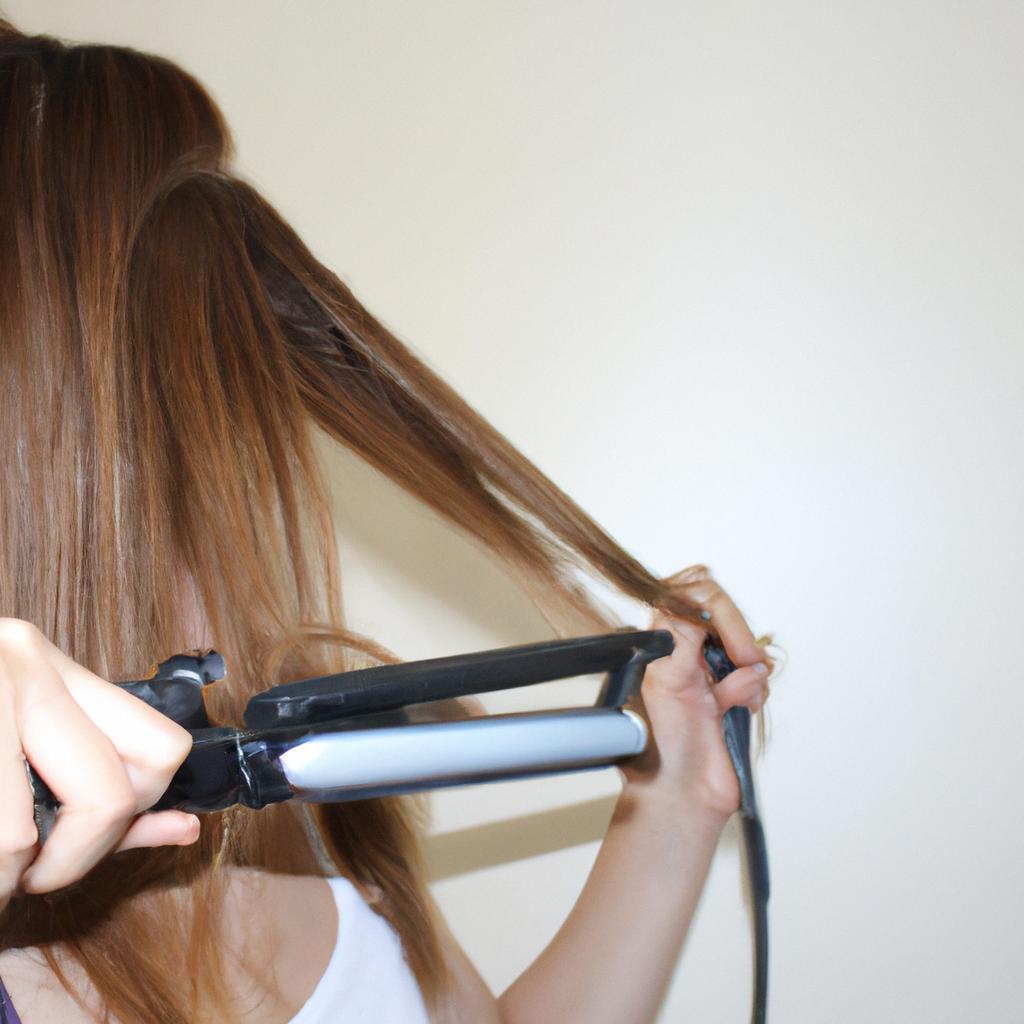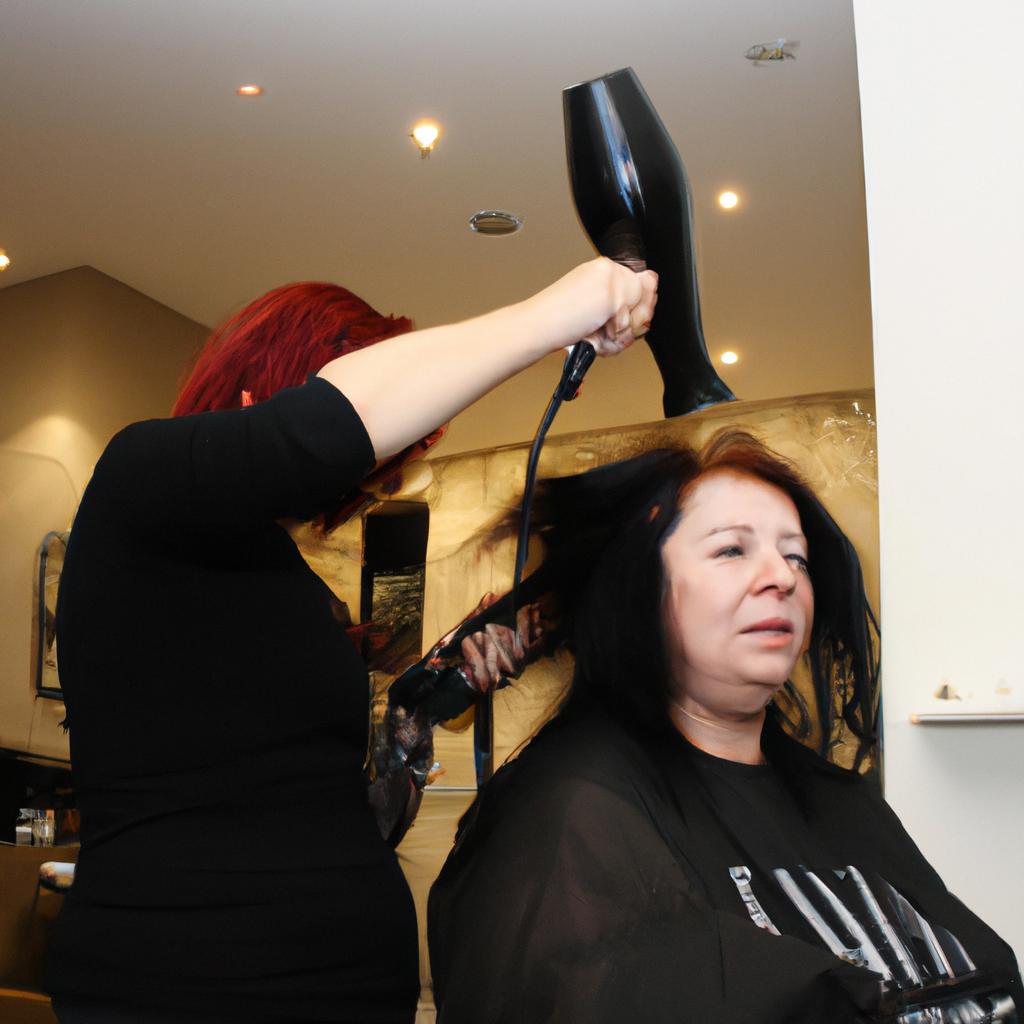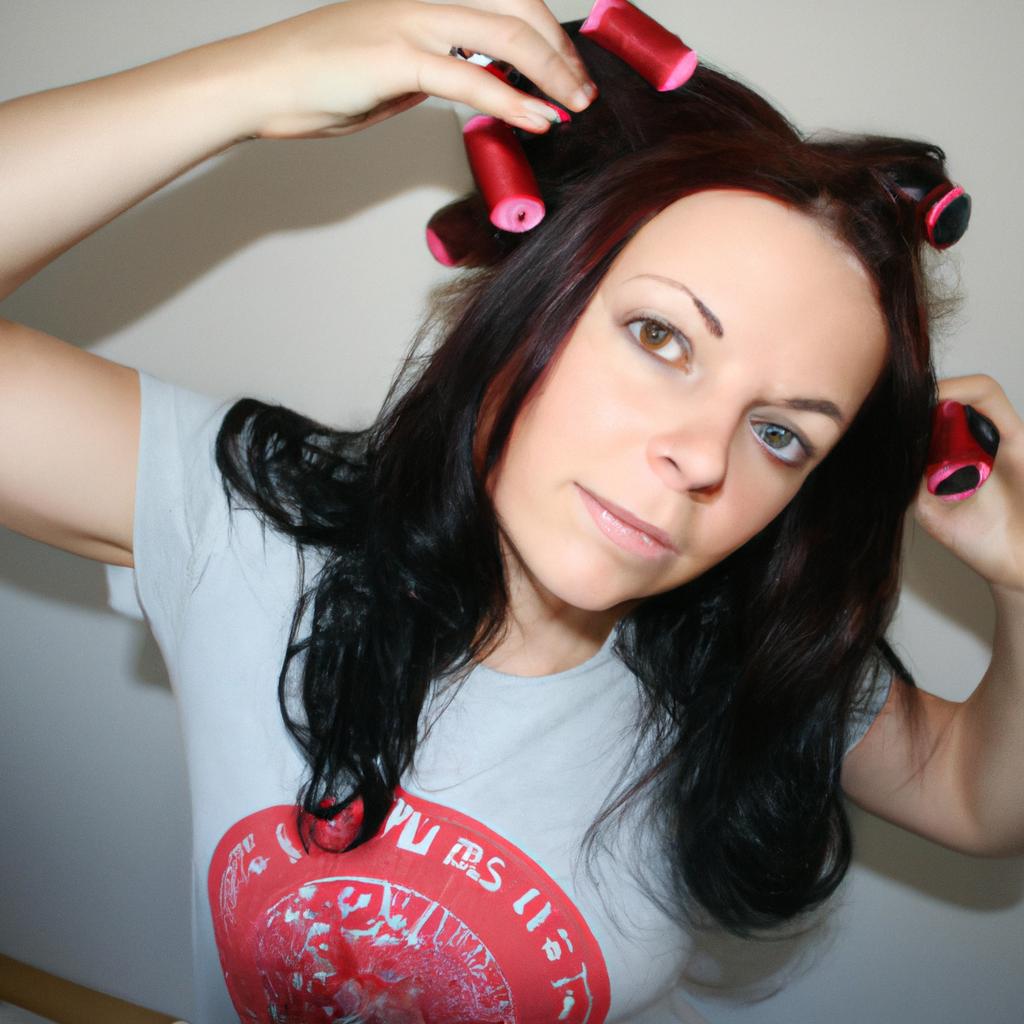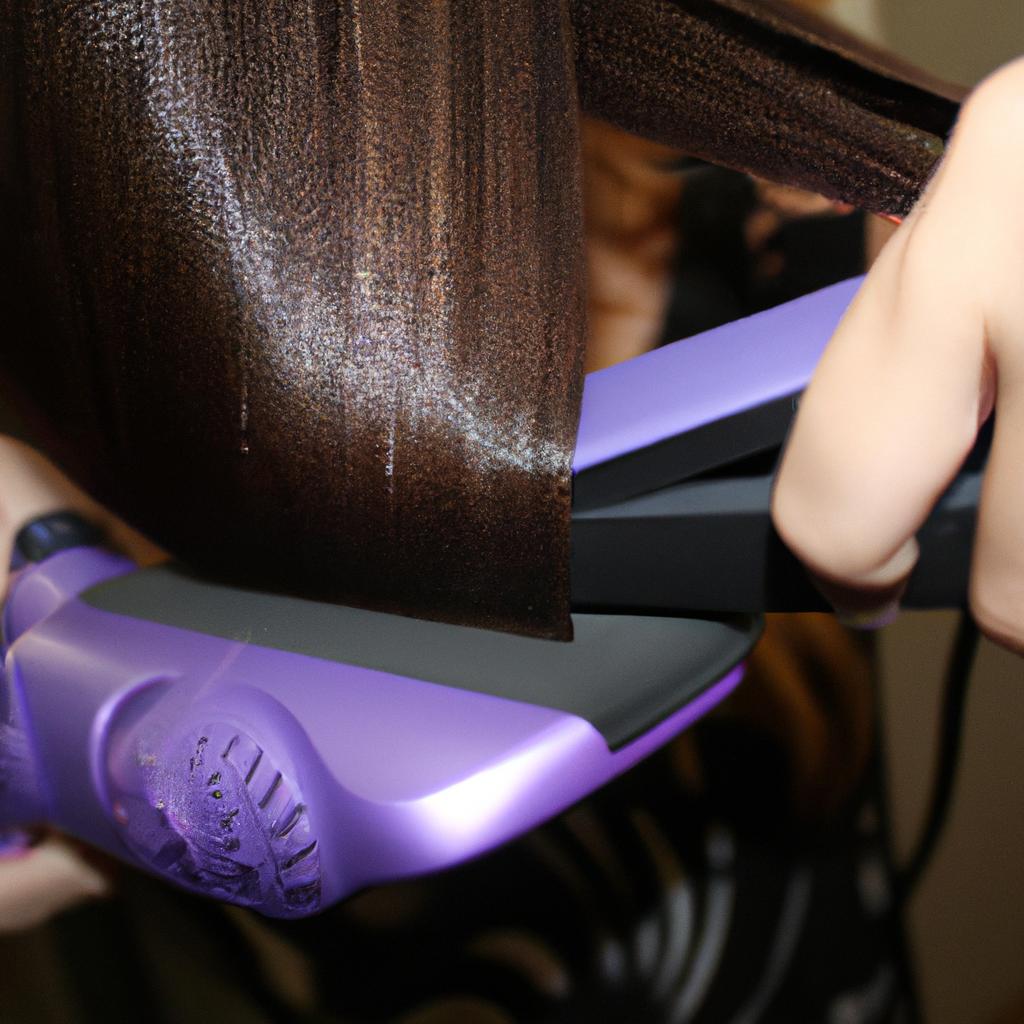Curling irons have long been a staple tool in the hairdressing industry, offering versatile styling options for clients seeking to transform their locks. One such example is Emma, an aspiring actress who recently visited a renowned salon with her straight and lifeless hair. Seeking a glamorous makeover for an upcoming audition, she entrusted the skilled hairstylists at the salon to work their magic using a curling iron. This article aims to provide a comprehensive guide on utilizing curling irons effectively within a hairdressing salon setting.
In today’s highly competitive beauty industry, stylists must be equipped with not only technical skills but also knowledge of various tools that can enhance their craft. The curling iron stands as one such essential tool that allows them to create stunning looks and cater to diverse client preferences. By understanding the different types of curling irons available, ranging from traditional clamp-style irons to modern wand-style ones, professionals can make informed decisions when selecting the most suitable option for achieving desired results. Furthermore, this guide will delve into crucial factors such as temperature settings, barrel sizes, and material compositions which play pivotal roles in determining how curls or waves are formed and set in place.
By delving into the intricate details surrounding curling irons, stylists can gain a thorough understanding of how to effectively use this tool in their salon. They will learn about the importance of prepping the hair with heat protectant products, sectioning techniques for efficient styling, and appropriate curling techniques such as wrapping versus clamping. Additionally, this guide will provide tips on creating different types of curls or waves, ranging from tight ringlets to loose beachy waves, allowing stylists to cater to a wide range of client preferences.
Moreover, maintaining the health and integrity of clients’ hair is paramount, and this guide highlights the significance of using high-quality curling irons that distribute heat evenly and minimize damage. It emphasizes the importance of regular cleaning and maintenance to prolong the lifespan of the iron and prevent product buildup or residue.
Furthermore, safety measures are crucial when working with heated tools, and this guide covers essential precautions that stylists should follow to ensure both their own safety and that of their clients. From proper handling techniques to avoiding overheating or burning the hair and scalp, these guidelines prioritize a safe and comfortable experience for everyone involved.
Lastly, this comprehensive guide aims to inspire creativity by showcasing various styling ideas using curling irons. Stylists will be introduced to innovative techniques such as combining curls with braids or twists for unique updos or incorporating accessories like ribbons or flowers to enhance the overall look.
In conclusion, mastering the art of utilizing curling irons effectively within a hairdressing salon setting requires knowledge not only of technical aspects but also an understanding of various factors such as tool selection, temperature settings, barrel sizes, material compositions, styling techniques, maintenance practices, safety measures, and creative possibilities. By equipping themselves with this comprehensive guide, stylists can confidently create stunning looks for their clients while prioritizing their hair’s health and ensuring a safe experience overall.
Different types of curling irons
Imagine you are getting ready for a special event and want to create beautiful curls that will leave everyone in awe. One tool that can help you achieve this is a curling iron. With its ability to transform straight hair into stunning waves or tight ringlets, the curling iron has become an essential tool in many people’s hair care routines.
There are several different types of curling irons available on the market today, each offering unique features and benefits. Understanding these options can help you make an informed decision when selecting the right curling iron for your needs.
Firstly, let’s consider the material used for the barrel of the curling iron. Ceramic barrels provide even heat distribution, reducing potential damage to your hair. Titanium barrels offer quick and efficient heating, making them ideal for those who are short on time. Tourmaline-infused barrels emit negative ions that lock moisture into your hair, resulting in smooth and shiny curls.
Next, we have the option of clipless versus traditional clip-style curling irons. Clipless curling irons eliminate the need for a clamp, allowing for more versatility in creating different styles such as beachy waves or spiral curls. On the other hand, clip-style curling irons offer better control over sections of hair and prevent tangles while styling.
Additionally, there are dual voltage curling irons designed for travel purposes. These handy tools allow you to style your hair anywhere in the world without worrying about compatibility issues with electrical outlets.
To summarize:
- Ceramic barrels: Even heat distribution
- Titanium barrels: Quick heating
- Tourmaline-infused barrels: Moisture-lock technology
- Clipless vs clip-style: Versatility vs control
- Dual voltage: Travel-friendly convenience
In conclusion, understanding the different types of curling irons available empowers you to choose a tool that best suits your specific hairstyling needs. Now that we have explored the various options, let’s move on to the next step: choosing the right barrel size.
Understanding heat settings
Transitioning from the previous section on choosing the right barrel size, it is essential to understand how heat settings play a crucial role in achieving your desired hairstyle with a curling iron. Let’s consider an example of Sarah, who has fine hair and wants loose waves for a casual evening out. She selects a curling iron with a larger barrel size but overlooks the significance of adjusting the heat setting.
To ensure optimal hairstyling results, it is important to comprehend the various heat settings available on curling irons. Here are some key points to keep in mind:
-
Temperature range: Different curling irons offer varying temperature ranges that can be adjusted according to your hair type and texture. Fine or damaged hair generally requires lower temperature settings (around 250°F), while thicker or coarse hair may need higher temperatures (up to 400°F). It is advisable to start at a lower setting and gradually increase if necessary.
-
Heat protection: Investing in a curling iron with adjustable temperature options provides you the opportunity to minimize potential damage caused by excessive heat exposure. Lower heat settings reduce the risk of frying your strands, maintaining their health and vitality over time.
-
Hair sensitivity: Consider your hair’s individual sensitivity when selecting appropriate heat levels. If you notice excessive frizz or dryness after using high heat settings, it might be beneficial to decrease the temperature next time.
-
Styling versatility: By understanding and utilizing different heat settings effectively, you can achieve versatile hairstyles ranging from tight curls to loose waves or even straightening effects depending on your preferences.
Incorporating these considerations into your hairstyling routine will not only help protect your precious locks but also enhance your overall styling experience. Now that we have explored understanding heat settings let us move on to our next topic – prepping your hair before using a curling iron.
[Table]
|—————–|——————–|——————|—————–|
| Hair Type | Temperature | Heat Protection | Sensitivity |
| Fine/Damaged | Around 250°F | Necessary | More prone |
| Thick/Coarse | Up to 400°F | Recommended | Less prone |
|---|
As we transition into the subsequent section about prepping your hair before using a curling iron, it is important to understand how these preparations can further enhance your hairstyling experience.
Prepping your hair before using a curling iron
Understanding Heat Settings
In the previous section, we discussed the importance of understanding heat settings when using a curling iron. Now, let’s delve deeper into this topic and explore how different heat settings can affect your hair.
Imagine this scenario: Sarah, an avid user of curling irons, recently purchased a new model that offers multiple heat options. Excited to try it out, she decides to experiment with various settings on her already damaged hair. She starts at the highest temperature setting without considering the potential consequences.
- High Temperature Setting:
Using a high temperature setting may seem tempting, as it promises quick results and long-lasting curls. However, excessive heat can be damaging to your hair in several ways:
- Increased risk of split ends and breakage
- Loss of moisture leading to dryness
- Fading or altering the color of dyed hair
- Weakening of hair strands over time
- Medium Temperature Setting:
Opting for a medium temperature is often recommended by stylists and professionals. This setting provides a balance between achieving desired results and minimizing damage caused by excess heat:
- Reduced likelihood of frizz and flyaways
- Less damage compared to higher temperatures
- Suitable for most hair types, especially those prone to heat damage
- Retains some natural shine and moisture in the hair
- Low Temperature Setting:
A low temperature setting might take longer to achieve the desired style; however, it offers numerous benefits, particularly for individuals with fine or fragile hair:
- Minimizes heat-related damage significantly
- Adds volume while maintaining softness and flexibility
- Protects against excessive drying or brittleness
- Ideal for daily use or touch-ups on already styled hair
To further illustrate these differences effectively, consider this table comparing each temperature setting based on their effects on typical hairstyles:
| Temperature Setting | Effects |
|---|---|
| High | – Promotes long-lasting curls |
| – Increases risk of split ends and damage | |
| Medium | – Balances results with minimal damage |
| – Suitable for most hair types | |
| Low | – Minimizes heat-related damage |
| – Adds volume and maintains softness |
By understanding the potential consequences associated with different heat settings, you can make informed decisions when using a curling iron. In the subsequent section, we will explore various techniques for curling different hair types. So let’s move on to discovering how to achieve stunning curls while considering your unique hair characteristics and needs.
Techniques for curling different hair types
From prepping your hair to mastering various curling techniques, using a curling iron can elevate any hairstyle. In the previous section, we discussed how to prepare your hair before using a curling iron. Now, let’s explore different techniques that cater to specific hair types.
Imagine you have fine, straight hair and desire soft, natural-looking curls. To achieve this style, start by applying a heat protectant spray evenly throughout your dry hair. Then, divide your hair into sections and clip them up securely. Take small strands of hair and wrap them around the barrel of the curling iron away from your face. Hold for a few seconds before releasing the curl gently. Repeat until all sections are curled, then run your fingers through the curls for a more relaxed look.
Now let’s delve into some key techniques for varying hair types:
- Thick or coarse hair: This type of hair may require higher heat settings on the curling iron to ensure long-lasting curls.
- Curly or wavy hair: Using a smaller barrel size will help define existing curls or waves without adding excessive volume.
- Short or layered haircuts: Opt for a thinner barrel size to create tight curls that add dimension and movement.
- Long or heavy hairstyles: Consider using larger barrel sizes to achieve loose waves rather than tight curls, as they can weigh down longer locks.
To further illustrate these techniques, refer to the table below which highlights recommended barrel sizes based on different hair types:
| Hair Type | Recommended Barrel Size |
|---|---|
| Fine and Straight | 0.75 – 1 inch |
| Thick or Coarse | 1 – 1.25 inches |
| Curly/Wavy | 0.5 – 0.75 inch |
| Short/Layered | 0.5 – 0.75 inch |
Using the appropriate techniques and barrel sizes for your hair type will help you achieve the desired curls or waves. Remember to always prioritize the health of your hair by using a heat protectant spray and avoiding excessive heat exposure.
Transitioning into the subsequent section on caring for your curling iron, it’s essential to maintain its longevity and performance. By following simple maintenance steps, you can ensure that your curling iron stays in excellent condition while delivering fabulous results every time.
Caring for your curling iron
Having learned about the various techniques to create stunning curls on different hair types, it is equally essential to understand how to properly care for your curling iron. By following these maintenance tips, you can ensure that your tool remains in optimal condition and continues to deliver fabulous results.
Section – Caring for Your Curling Iron:
To illustrate the importance of proper curling iron care, let’s consider a hypothetical scenario involving two hairstylists working at a busy salon. Stylist A diligently maintains her curling iron after each use while Stylist B neglects hers. Over time, Stylist A’s curling iron performs consistently well, providing excellent heat distribution and longevity. In contrast, Stylist B experiences frequent issues such as inconsistent temperatures and damaged cords due to negligence.
When caring for your curling iron, keep the following points in mind:
-
Regular cleaning: To prevent product buildup and maintain optimal performance, it is crucial to clean your curling iron regularly. Use a damp cloth or cotton swab soaked in rubbing alcohol to wipe away any residue on the barrel.
-
Storage considerations: Proper storage prevents unnecessary damage. Ensure that your curling iron is completely cool before storing it in a designated space where it won’t be exposed to excessive moisture or extreme temperatures.
-
Avoid using excessive heat protectants: While heat protectant sprays are beneficial when styling with hot tools, applying too much product can lead to residue buildup on the barrel. Follow the recommended usage guidelines provided by the manufacturer.
-
Routine inspection: Regularly inspect your curling iron for signs of wear and tear such as frayed cords or loose connections. If any issues are detected, promptly seek professional assistance or contact customer support for guidance.
Table: Common Issues and Solutions
| Issue | Solution |
|---|---|
| Inconsistent heat | Ensure proper connection to power source |
| Uneven curls | Clean the barrel thoroughly before use |
| Damaged cord | Avoid excessive twisting or bending |
| Overheating | Allow sufficient cooldown time between uses |
By adhering to these care tips, you can prolong the lifespan of your curling iron while ensuring optimal performance. Remember that a well-maintained tool not only enhances your styling abilities but also safeguards against potential mishaps caused by neglect.
Incorporating appropriate maintenance practices into your hairdressing routine will undoubtedly contribute positively to both client satisfaction and professional growth.




